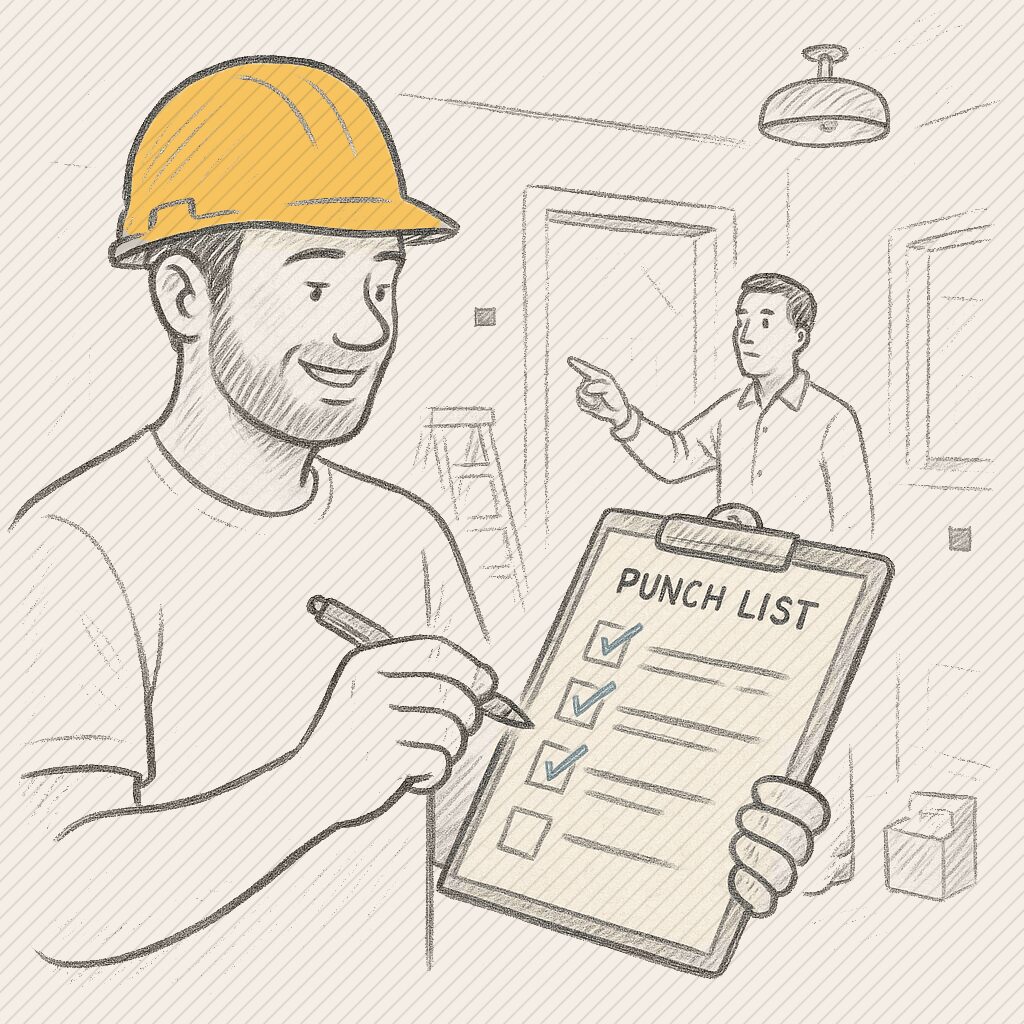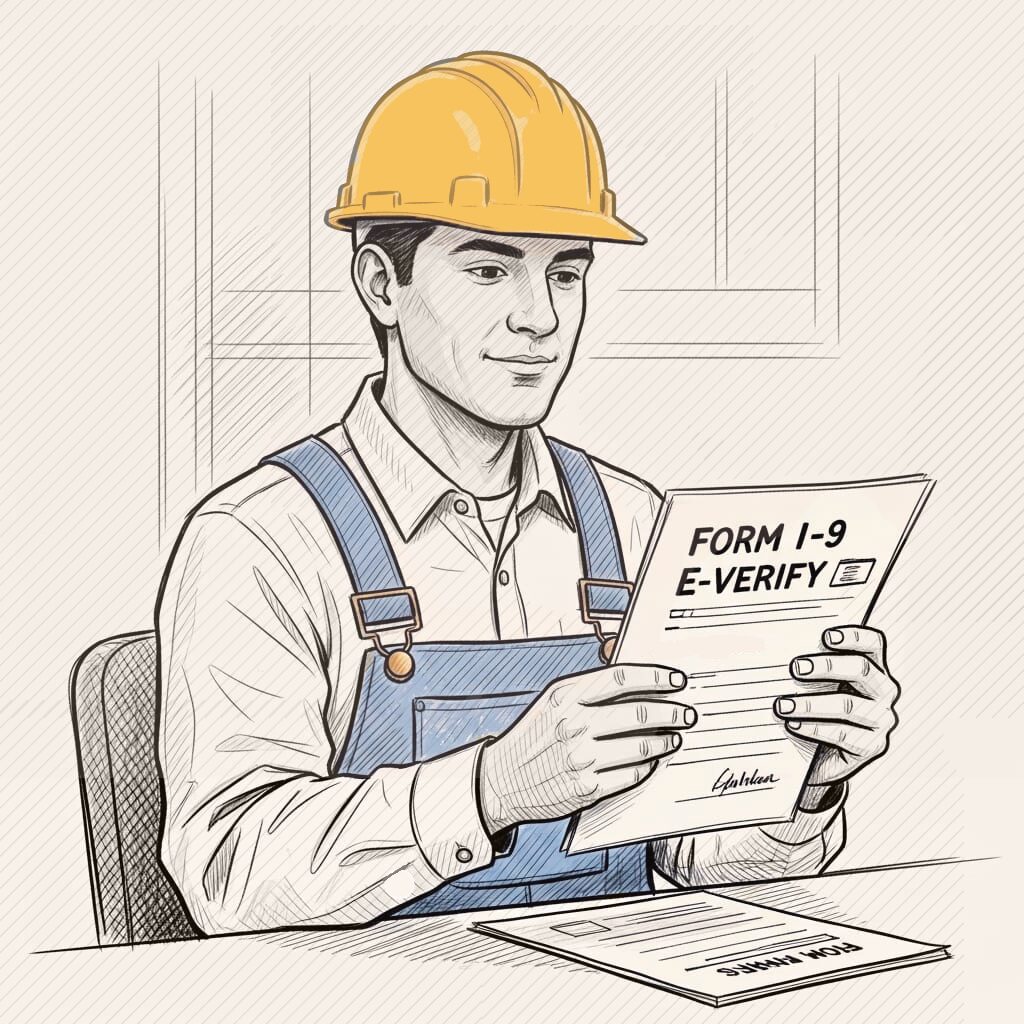You’ve just finished a construction project. The owner walks through and points out a few scuffs, a misaligned cabinet door, and a missing light cover. You jot these down on a punch list – the final to-do list of minor fixes before the job is truly done. You take care of those items, collect your final payment, and head to the next job. A few months later, the owner calls about a leaky faucet or a cracking drywall seam and says, “Hey, you forgot this on the punch list!” Not so fast.
At that point, you’re likely dealing with warranty work, not punch work. Knowing the difference between punch list items and warranty repairs isn’t just semantic – it can affect when you get paid, what you’re obligated to fix, and even your legal exposure. In Florida, this distinction is more important than ever, thanks to a new law requiring a 1-year builder’s warranty on new homes. In this article, we break down the punch list vs. warranty debate, unpack the new Florida warranty law, and help contractors stay sharp, get paid, and avoid trouble.
What Is a Punch List? (Finishing Touches Before Final Payment)
A punch list is essentially the project’s final honey-do list – a compilation of small finishing tasks or corrections that must be completed before the project is fully complete. One Florida court nicely defined punch list work as “a final list of small items requiring completion of finishing, corrective or remedial work under a construction contract”. In plain English, these are the minor fixes or touch-ups identified at the end of a job.
Typically, after substantial completion (when the project can be used for its intended purpose), the owner or inspector will walk through and note any remaining issues: paint touch-ups, replacing a scratched window screen, adjusting a door that sticks, cleaning up debris, etc. These items go on the punch list.
From a payment perspective, punch list items may be tied to the release of final payment. The owner might try to withhold some money—retainage or a final installment—until the punch list is done. But that only works if the contract actually allows it. It’s not uncommon, and often written in the contract, for final payment to be withheld until all punch list items are completed.
That keeps everyone motivated to wrap up the loose ends. Punch list work is considered part of the original contract scope—not extra work, just finishing what was promised. Under Florida construction law, once you’ve reached substantial completion, only minor details and corrective work (i.e. punch list items) should remain. “Final completion” usually means everything, including punch list fixes, is done and the owner is satisfied. The goal for any contractor is to tackle the punch list quickly, get the owner’s sign-off, and close out the project with payment in full.
Pro tip: Do not treat punch items as an afterthought. Document them in writing, get the owner to agree that the list is complete when you’re done, and consider having them sign a completion or handover form. This can prevent disputes later where an owner claims something was “missed” on the punch list that actually came up after they moved in. Once the owner takes occupancy or the project is otherwise finalized, anything new that pops up is generally not part of the punch list. That’s where warranty comes into play.
What Is Warranty Work? (The “After the Job” Promise)
Warranty work refers to issues that arise after final completion – problems with the work that become apparent once the owner has started using the building. In construction, a warranty is essentially the contractor’s guarantee of quality and performance of their work. It’s a promise to fix certain defects or failures that show up within a defined time after the project is done.
Most construction contracts include an express warranty (often for one year) on workmanship and materials. Even if a contract doesn’t spell it out, there can be implied warranties (like the work was done in a competent, code-compliant manner). In short, warranty work means you, as the builder, might have to come back and make things right after you thought the job was over – but only for issues that meet the warranty criteria (more on that soon).
Key point: Warranty repairs are not part of the original punch list or contract completion. They are post-completion obligations the contractor has agreed (or is required by law) to honor. One way to distinguish warranty work is that it’s usually triggered by some kind of post-completion failure – something that wasn’t obvious at the final walk-through.
For example, a month after move-in, the homeowner notices the hardwood floors are warping – that’s likely a warranty issue (perhaps a defect in installation or materials). Or the HVAC stops cooling during the first summer – if it’s due to your installation, that’s a warranty call. These are not things anyone could have put on the punch list at closeout because they often manifest later.
Like punch list items, warranty work is typically done at no additional cost to the owner – but for a different reason. Punch work is part of the original contract scope: no new charges, no change orders, just finishing what was promised. Warranty work, on the other hand, is covered by your post-completion guarantee.
And unlike punch list items, the owner can’t legally withhold final payment for a future warranty issue that wasn’t evident at the time of completion. (If they try, you’re within your rights to insist on payment – you can’t hold payment hostage for hypothetical problems.)
From a legal standpoint, warranty work is treated differently too. It’s usually not something you can charge extra for or file a lien over, because it’s not considered a new improvement – it’s a correction of work already performed. Florida courts have made it clear that performing warranty work after project completion does not extend your lien rights. Once your lien deadline runs out, doing repairs under warranty won’t restart the clock.
Most standard warranties in construction last one year (though some specific equipment or structural warranties can be longer). That means for one year after final completion or owner occupancy, the contractor agrees to fix certain defects that arise. After that, any lingering defects might fall under other legal theories (for example, if a serious latent defect emerges, the owner might invoke Florida’s construction defect law for relief), but the freebie period of the contractor’s warranty is typically over.
Important: Warranty doesn’t cover everything – usually just defects in workmanship or materials under normal use. If the owner’s kid slams a scooter handle into the drywall while doing donuts in the living room, sorry — that’s not a construction defect; that’s life. Warranty is about the contractor’s work quality, not wear and tear, accidents, or homeowner hijinks. If the ceiling fan wobbles because they tried to hang a hammock from it, or their cousin drilled into a pipe trying to mount a flatscreen, that’s on them. Warranty doesn’t cover damage from furniture wars, plumbing experiments, or “my buddy said he could fix it” disasters.
Punch List vs. Warranty: Key Differences
- Timing: Punch list items show up before final completion — they’re the last few things standing between you and getting paid. Typically spotted during the final walkthrough, they’re minor fixes you handle right away. Warranty issues pop up after the owner moves in. If they call weeks or months later about something failing, you’re in warranty territory.
- Payment: Punch list = finish the job to get your final check. Owners may be entitled to withhold retainage or final payment until punch work is done — if the contract says so. Warranty work? No payment attached. You’ve already been paid. If the issue is covered under the warranty, you’re obligated to fix it at your cost. The owner can’t legally hold back money from months ago over something that just broke.
- Scope: Punch lists cover stuff that was missed, sloppy, or incomplete — not extra work, just tying up the contract. Warranty work covers defects that surface later: leaks, cracks, systems that fail under normal use. Warranty doesn’t mean the owner gets to invent a second punch list later on or start asking for upgrades. You’re fixing your work, not remodeling the place for free.
- Legal Exposure: Ignore punch work and you could breach the contract, risking withheld payment or even a backcharge. Blow off warranty claims and you might face a formal defect notice, a Chapter 558 process, or a full-blown lawsuit. Florida’s new law also gives homeowners a statutory right to enforce the one-year builder’s warranty on new homes.
Florida’s New 1-Year Warranty Law for Builders (Effective July 1, 2025)
Florida just made something that was common practice into mandatory law. Starting July 1, 2025, every builder of a new residential home — single-family, duplex, triplex, or fourplex — must provide a written, one-year warranty. That’s now baked into the law under § 553.837, Fla. Stat..
What’s covered?
The warranty must cover construction defects in materials, workmanship, or equipment that result in a material violation of the Florida Building Code. If something was built wrong and it fails — leaks, structural cracks, serious code issues — you’re responsible for fixing it within that first year.
What’s not covered?
You’re not on the hook for normal wear and tear, minor settling, damage caused by the owner or third parties, or defects in equipment that comes with its own manufacturer warranty (like a fridge or HVAC system). If the owner’s kid launches a toy into the drywall or their uncle installs a ceiling fan that shakes like a washing machine, that’s not your problem.
How long does it last?
The warranty runs for one year from the earlier of occupancy or title transfer. It automatically transfers to the next owner if the home is sold during that first year — you can’t escape the obligation by flipping the property.
Can you offer more?
Sure — you can always offer a longer or broader warranty. Just make it clear in writing that it exceeds the legal minimum, and whether it extends beyond the first year or to future buyers.
Who does this apply to?
It applies to new residential construction up to four units. Not remodels. Not commercial work. And it applies to the builder or general contractor who pulled the permit — not subcontractors.
What happens if you ignore it?
If you blow off a legitimate warranty claim, the owner can sue you directly under the statute — not just for breach of contract. There’s no dodging this. You can hire a third-party warranty company to handle claims, but you still have to provide the coverage.
Bottom line: if you already fix your mistakes, this won’t change much. But if you’ve been ghosting warranty calls or cutting corners to save a buck, Florida’s coming for you — one cracked foundation and angry homeowner at a time.
Tips for Contractors: Manage Both Punch Lists and Warranties Like a Pro
Now that we’ve drawn a bright line between punch list work and warranty work – and you’re aware of Florida’s new mandatory warranty – how should you, as a contractor, manage these in real life? Here are some parting tips (sprinkled with a little tough love):
Document Everything: During the final walkthrough, create a clear written punch list and have the owner sign off on it and later sign off that all items were completed to their satisfaction. This is your insurance policy against an owner claiming “incomplete work” later which was never on the list. It doesn’t mean you won’t address genuine warranty issues, but it shuts down attempts to recharacterize new issues as “leftover work.” Having a paper trail is golden if a payment dispute arises.
Educate the Owner (Tactfully): Most owners don’t know the difference between punch work and warranty work — they just call when something goes wrong. You don’t need to correct them, but you can steer the conversation. Try something like: “No problem, that’s covered under your one-year warranty. Just a heads-up — the punch list was wrapped up at closeout, and this came up afterward, so it falls under warranty.”
That lets them know you finished the job right and are now stepping up to honor your warranty — no drama, just professionalism.
Don’t Delay the Inevitable: If there’s a warranty issue, handle it quickly. Florida law gives you one year, but delays can cost you. Small problems can turn into big ones — and big ones can turn into lawsuits. Waiting too long frustrates owners, opens the door for them to call another contractor, and puts you on the hook for the bill. Fix it while it’s simple and still your call.
Put It in the Contract
Florida now requires a one-year warranty on new homes, but don’t stop there. Your contract should clearly spell out what’s covered, what’s not, how long the warranty lasts, and how claims should be made. Be upfront: once the warranty ends, so does your free repair service. Also make it crystal clear that wear-and-tear, owner damage, and mystery squeaks from their DIY shelving job aren’t on you. A well-written warranty clause can save you from endless “Is this covered?” phone calls.
Build It Right, and Make Subs Fix Their Stuff
The best way to avoid warranty calls? Do it right the first time. Easier said than done, sure — but quality work and solid materials cost less than legal fees and call-backs. And don’t forget your subs. If the plumber botches something, you’re still on the hook to the owner, but you should be able to drag that plumber back to fix it. Make sure your sub agreements require them to repair their screwups and cover any mess they cause. Cover your backside early, and often.
Know Your Dates
Track your substantial completion, final payment, and warranty periods. Florida’s statute of repose for latent defects is now 7 years — down from 10 — but that still means big claims can come long after the dust settles. Your one-year warranty doesn’t stop a lawsuit over serious hidden defects, so keep your records, keep your insurance, and know when the clock starts ticking.
By understanding the difference between punch work and warranty work, you’ll avoid doing free labor that wasn’t your responsibility — and avoid blowing off repairs that are. You’ll get paid on time, fix what needs fixing, and leave the job with fewer headaches. In construction, that’s about as close to a win-win as it gets.



